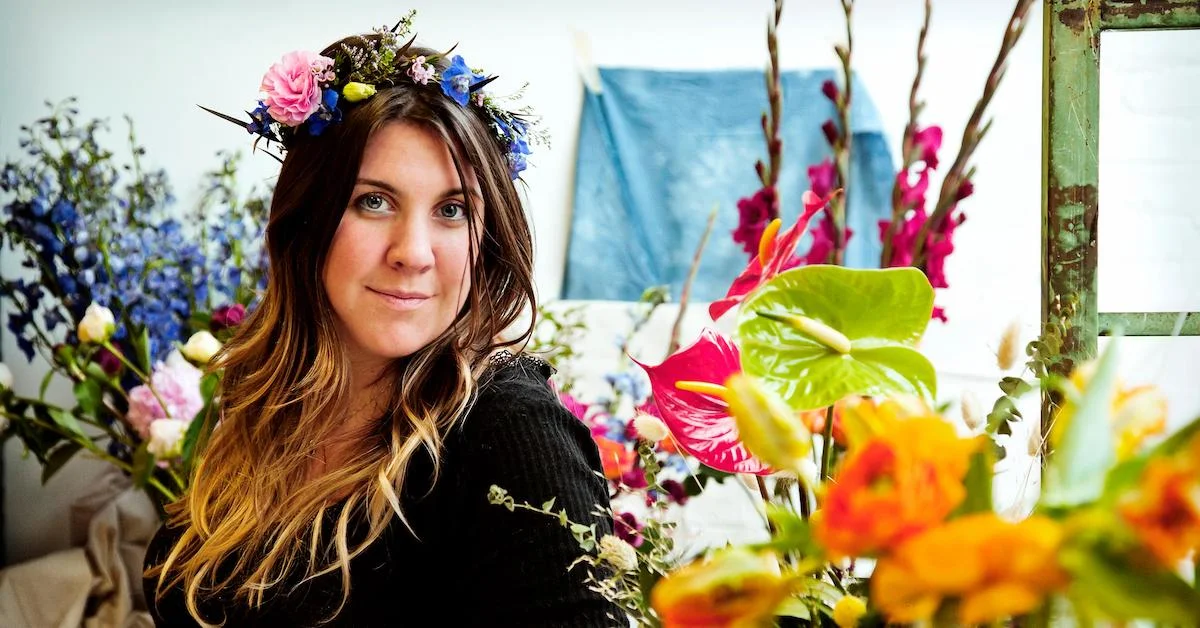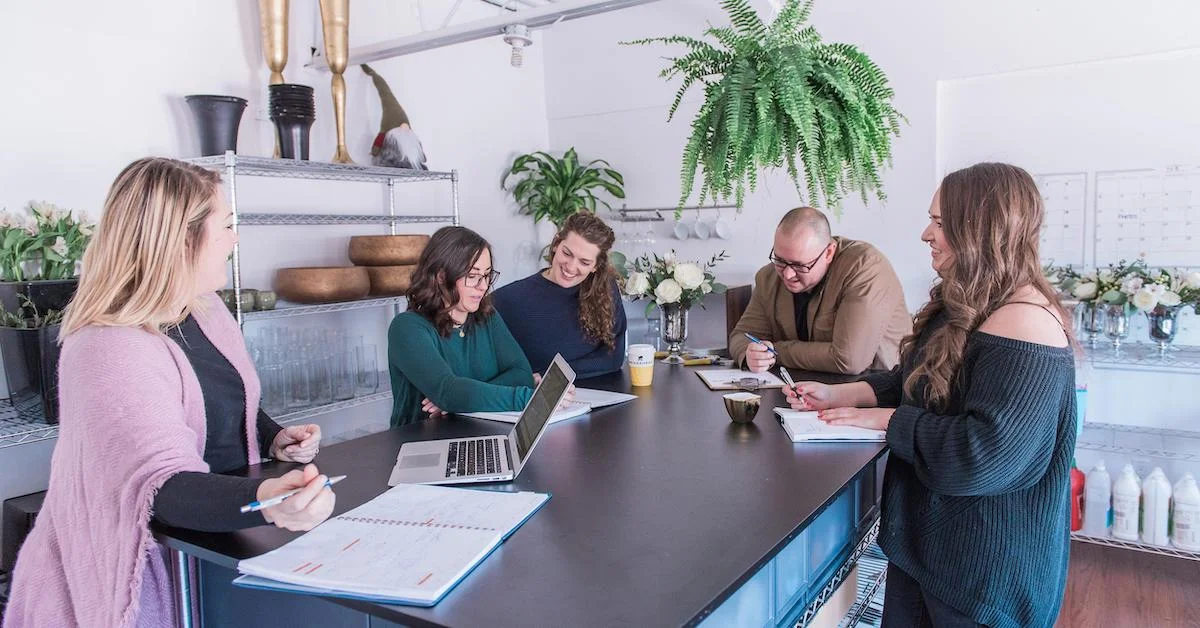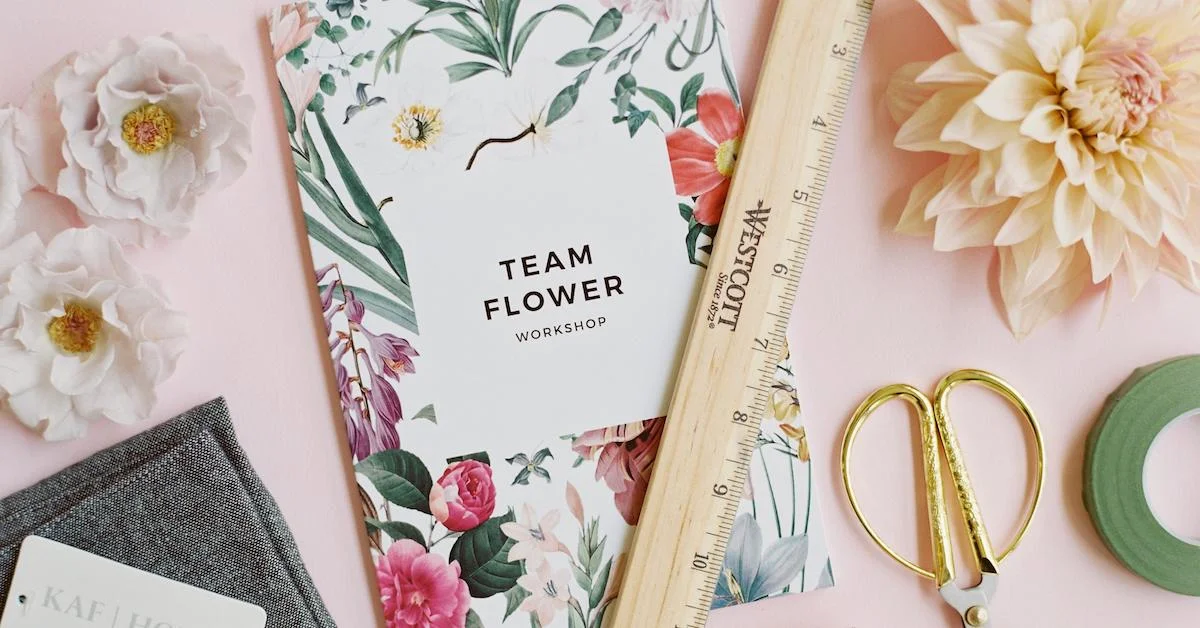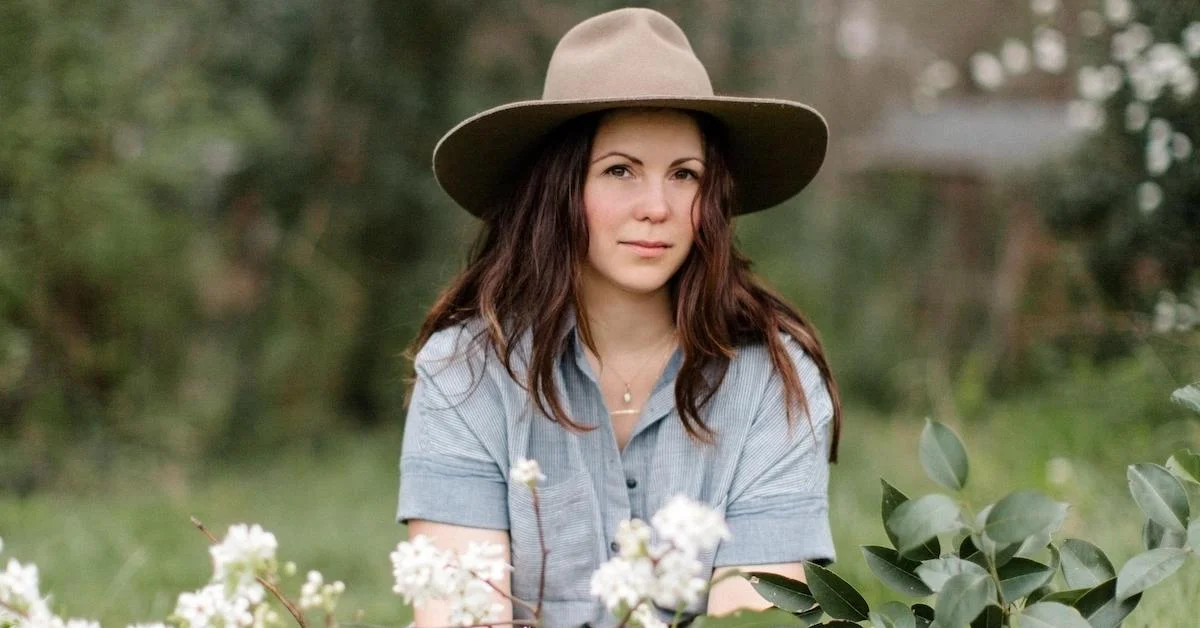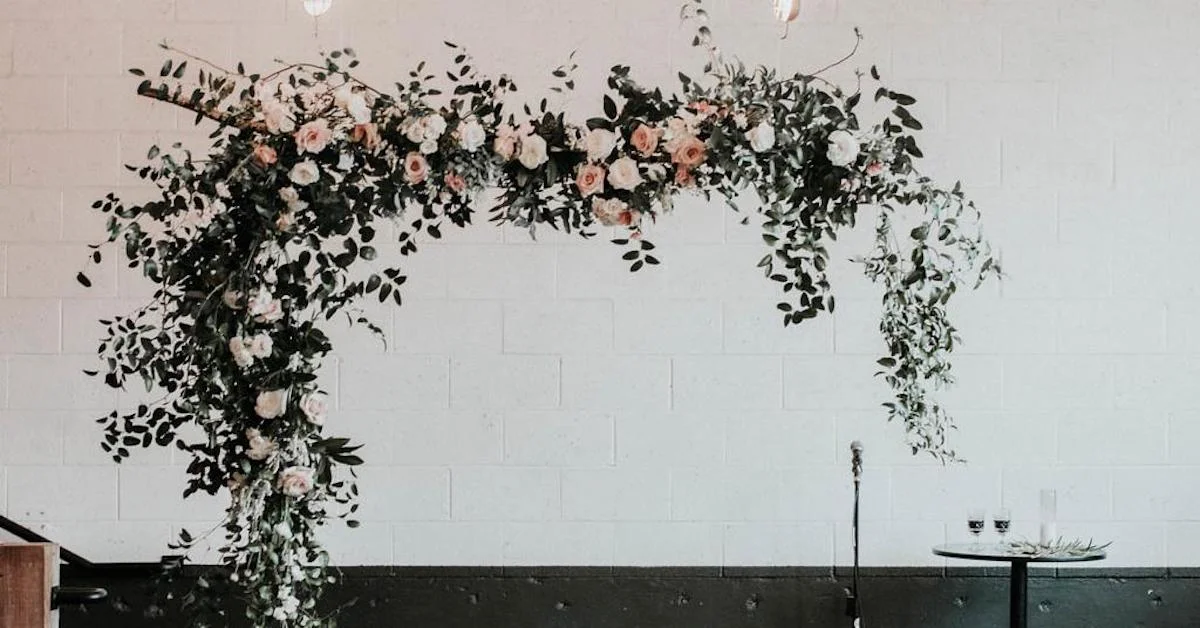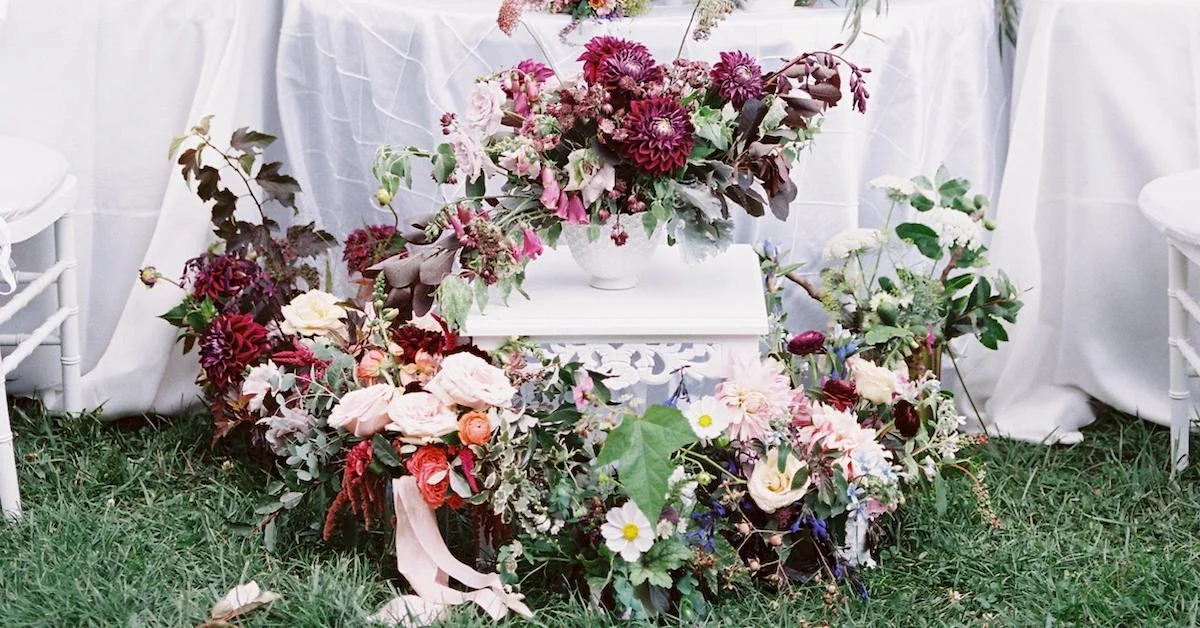In this springtime video, Kelly will show you how to pull together an arrangement perfect for an Easter lunch table. Learn how to become a florist and take floral design classes online with Team Flower. Here you can even learn tips on flower gardening for beginners. We'll show you how to do flower arrangements in flower arranging videos.
Transcript
Hi, I'm Kelly Perry with Team Flower. And I wanted to share an Easter centerpiece with you today. I'm reading this book called Flower Arranging Through the Year, by Daphne Vagg.
And in it there is a little idea. They call it pot-et-fleur. Literally means pot in flower. It evolved about 20 years ago to describe an arrangement of growing plants that are still rooted with a few cut flowers.
At times of the year when flowers are scarce or expensive, a pot-et-fleur can provide a type of decoration which has never really enjoyed the popularity it deserves for its economy and long life. A well-planted and cared for bowl will last for two or three years.
Well, maybe not if it lives in-- maybe not if it lives in my house. But if you're a good house plant person and very attentive, this is a great idea.
I love the concept behind it. In the book that they show here, they have some begonias, succulents, dusty millers, ivies, things like that. And then they've added in some little lilies.
A great idea to have some simple house plants that then you can, throughout the year, go back to and simple little if you need a little extra in a boutineer. Or just to have something fresh and growing in your house all the time that you can then take things they're blooming outside and add into your bowl, just to keep things fresh and fun. But it doesn't take maybe quite as much work as an arrangement.
So that is what we're going to do today. And I am using some things that I would probably plant these things out. It's not house plant kind of materials. But these are things that are available at the garden center now.
And we're going to plant them, pop them up here for our Easter bowl. And then after frost passes we're going to go ahead and plan these things out in the garden.
So my version is not as strict. But that's something that you could do is plant the house plants. And then follow the same kind of set up and concept to have something that's fresh and growing throughout the year.
So we are going to start by taking our terracotta pot. And I'm going to flip it upside down. I'd kind of like to age it a little bit, but I don't have time to go through the whole process of covering it and letting that process happen.
So I'm going to do a quick little cheat. And I'm going to just use some chalk. Some simple classroom chalk or some sidewalk chalk if your kids have some.
And I'm just going to go back and forth on my bowl with the chalk. And then we're going to smooth it over and kind of blend it all together just with a towel.
You will, of course, want to be careful when you pick this back up to take it in your house so you don't have chalk all over the front of you. But this is just a really quick way to get some interest, and texture, and age to your pot instantly. It's fun.
Kind of like we're giving her some makeup. Putting on the powder.
Now next, we're going to add some-- get a base level of some potting soil in here. We'll go back over where I just put a little thumb print. OK.
And I'm just using a simple Miracle-Gro potting mix from the hardware store that has some nutrients for the plants in it already. This is only designed to last for a little while in terms of nutrients for your plants. So you'll want to check the brand and the bag that you have to see what's in it, how long it will last, and what you'll need to add or supplement to keep your plants looking great long-term.
I know a lot of times with house plants-- I'm getting a little bit better at them. But I was on a real losing streak with them because I kept getting insects in the soil.
And so I did some Dawn dish detergent and have been doing flower food in them regularly. And that's really helped. So maybe my black thumb of death is going to leave here pretty soon.
OK. We're going to add these first. They're just a sweet little-- what was this called? Saxi-- frage? Fr-ah-g? Did we look this-- we looked this up and-- oh, man.
If I haven't heard it said before. I have a tough time with that sometimes. But it is spelled highlander white. And it's S-A-X-I-F-R-A-G-E.
I'm just going to break up this little bit at the bottom so that the roots can move around in the pot. And I chose two different ones. This one has more compact flowers and this one was a little bit leggy looking. But I liked that because I can have this one that is doing a little bit more movement come and drape down the front like this.
So I'll tuck that little baby in the there. I'm going to add-- I have some different kinds of lettuces. I guess this is a lettuce, a kale, and I think this is cabbage. Yep. A little bit of cabbage.
That one I lost. I tell people a lot with cut flowers, feeling the flowers to know if it's going to hold well for use a cut if you're cutting some things from your garden. If you feel lettuce it feels very tender and soft. And then if you feel this cabbage down here it's very leathery.
That Cabbage will do just fine out of water. But the lettuce, you'll have a little bit more wobbling around. And we're experiencing that even now just here on the plant. The cabbage and kale over here, same thing.
And I wanted to have a little bit of lettuce in here. Have a little spring garden. Thought it would be sweet. So we'll see how it does.
Let's put a little thyme in here next. Thyme is one of my-- this is a lemon variety. I love thyme.
It's very sweet smelling. It's great to have on hand for cake decorating flowers if you do wedding flowers. I like to use that on wedding cakes a lot. Of course, I make little cookies and Jesse and I had it in scrambled eggs the other morning.
When I was choosing these plants at the garden center I was thinking about the different shapes of the leaves and how they might look grouped together. I wanted to have some varieties, so that's why we have long lettuce leaves.
And these cabbage leaves have just a little hint of purple in them, which I really liked. Just add a little bit of depth to our green. It's, of course, primarily green. But I wanted to have a little hint of color.
Now This, you could plant the whole thing in the ground I suppose. I want to liberate it for what we're doing.
It has become-- the roots have come bound around the bottom of this. Try not to disturb them too much but let them go free so they can keep moving.
Easter is one of my favorite-- well it is my very favorite holiday. So I'm excited about this one. Parents are coming down to visit. And we'll have our little brunch with this centerpiece.
Nice thing about these is you can do them in advance and keep an eye on them, keep them watered, and happy. And that's one less thing you have to do when company comes. You don't need to be arranging fresh flowers. You can just touch your potted arrangement up and pay attention to your guests.
OK. I think I'm going to reserve these last two, just in case we need them. And I'm going to fill in with a little bit more potting soil. Then we're going to add some fresh flowers.
And these daffodils will be-- they will be all done blooming. They will have lived their life by Easter for me right now. But there will be more in the garden when Easter rolls around and I'll run out pick some more.
Same with-- I think we're going to add some forsythia to this. It's a great plant to use.
But again, that forsythia will actually very likely still be looking great for me around Easter. Forsythia is one of those flowers that roofs in water. And those kinds of things are always very long lasting in arrangements.
I don't know if you've ever noticed ivy. If you cut ivy and put it in a vase, it will start to shoot out little roots at the bottom. Maybe after about two weeks of being cut.
And forsythia acts the same way. That's how it spreads in the ground and multiplies is by putting out roots. So that is a great, great cut. Great thing to have in your garden if you don't have already. OK. Cute.
So to put these flowers in, I'm going to use some little water picks. But I wanted to show you a few other options.
In the book, whenever they talk about putting together the pot-et-fleurs, they have thin little containers or little vessels that they actually plant in the soil that then they can put their little bouquet in. So I wanted to show these. These would be great little things that you could plant in there. With what we're doing with it being so low and just the shape of what we're doing today, this isn't what I need.
We could, if we wanted to, perhaps use this. This is a little pin frog cup that you can put a little bit of water down in here. And then you have the pins that you can set the flowers in and around.
So I'm going to just-- there's a little place right here that I've created that would be fine to put that in. Since it's green it mixes in with the things that we have. I'm just going to put a little bit of water in that.
And since I might want to put some flowers in a spot other than this or maybe just one little flower over here, I also have some water tubes to use as well. And they just look like this if you haven't used them before. They have a little poke and you just poke it down in there. And then kind of hide the mechanics of that as needed.
So I'm going to start with the forsythia. And I'm going to use this to create the kind of more interesting shape at the top. We've filled in the base of our arrangement. But now opposite of this rosemary that's probably the most prominent thing that we have coming up, I'm going to do the forsythia right over here.
And I'm not getting real serious about precisely how this is going in there. I want it to feel casual and just that it was a walk in the garden. But naturally, just because that's how my eyes bend, I'm thinking about the lines and the movement that I'm creating in the arrangement with the pieces that I put in.
And then the little daffodils. You can see how they get this little-- where they've been living and forming. You can just pull that off and liberate the flower. So there she is. Glad and ready to roll.
I'm going to take a quick peek at my flowers. See which ones are the biggest, which ones are medium, which ones are small. That helps me as I place them.
You place larger flowers at the base of the arrangement and smaller ones higher. It feels a little bit more grounded, I guess is the word you could use to describe that.
And as I place the flowers in, I'm thinking about just putting maybe one a stair step above the other, rather than crunching them together. Because I want this to just look like they're growing there.
And as you go out and gather your flowers, you don't have to use daffodils. You don't have to use forsythia. Use whatever is in your garden.
But notice as you bring it in and as it's growing there, just the natural bend to the flower and how it seems to grow. And if you mimic that kind of look as you arrange it in the bowl, you'll get a nice garden feel.
So I'm going to show you-- I have this one in here and I'm going to take it out. And I'll show you why I think-- I mean it could stay there.
But I kind of think it's a stronger composition to me if I just pull this out and we have that. These were kind of on the same level and similar. So I'm just going to readjust how this one is facing. Maybe use it a little bit further back in the arrangement.
So now I'm going to work this angle. And see how as we do this we're creating depth in the arrangement. You can tell that it's moving backwards here just a little bit more. Movement.
You really could, I think, stop there with the flower placement. What I might do with some of these other smaller daffodils that I have is just create a small little grouping in a little bud vase and put these in front of each person seat. I think that would be a sweet way to use the rest of these.
And I wanted to add in my little bunny here. I have two younger sisters. And the one next in line to me, her name is Kristin. But we-- from the day she was born she just looked like the sweetest little snugly bunny. And the name stuck.
So this is little bunny right here. She can't make it down to Easter. So we're going to put this little-- we're going to put this little bunny in here to remember Kristin. I think we will put that right here. Cute.
And just these last two that I have. There's a little spot back here. I'm going to fill them in.
OK. I think that took care of that. I think we're done.
Another thing you might want to do down the ends of the tables. I know everybody's dinner tables are a little bit different. Some people are eating family style. Some people are having it on a buffet or something like that. So just a few other things.
So the daffodils in the bud vase is another way that you could add and make something with this. And then there are little sweet terracotta pots that you can get at the hardware store. They have little tiny mini ones too. That might be something that's sweet that you could put at each person's place setting.
And I also have some carrots and I have some cabbage leaves. I took some leaves off. And I have the actual cabbage head here. You can arrange these down your table and make it sweet and special.
Or you might even consider using one of these cabbage leaves as maybe a place card. Maybe you paint, just with some little-- bit of acrylic paint, you paint their little name in there as a place card. Or you could serve a chicken salad in it, you know. Whatever you think.
But there's so many sweet ways you can use something like this. And what a beautiful leaf, all the colors and veins within the leaf. So those are a few little ideas for you with that.
I already mentioned planning it out after you're finished using it as your centerpiece. And don't want to forget to give it a little bit of water here before we sign off as well, since we've disturbed those-- disturbed those roots, go ahead and get them some water back to their way.
So that's what I've got for you. Wishing you a wonderful, wonderful Easter. And hope that you enjoy spring and all the beautiful things that it has to offer.
Talk to you soon. Have a great day.


